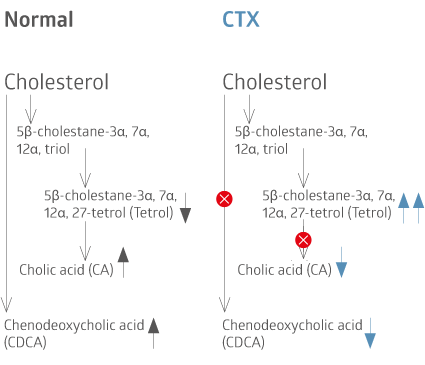About CTX:
CTX (cerebrotendinous xanthomatosis) is a rare and serious disease of bile acid metabolism with an estimated incidence of about 1:50,000. The disease is caused by a hereditary genetic defect of the CPY27A1 gene resulting in a deficiency of the mitochondrial enzyme sterol 27-hydroxylase. Insufficient
enzyme activity leads to the accumulation of cholesterols characterized by lipid deposits (xanthomas) in the brain, tendons, and other regions of the body.

With CTX, the accumulation of cholesterols leads to progressive neurological damage but could also affect cardiovascular systems. CTX-related symptoms can occur as early as infancy with neurological deterioration typically beginning in early adulthood. The signs and severity of symptoms vary with age and early symptoms can include chronic diarrhea (infants) and cataracts (children) then progressing to impaired motor function, impaired speech, or dementia.
The selective diagnosis of CTX presents a challenge for physicians due to reduced information on the natural history of the disease and non-specific symptoms resulting in CTX diagnosis happening in adulthood after neurological symptoms are present. In recent years, innovative diagnostic methods (including tandem mass spectrometry) have been developed that can deliver a faster diagnosis even in the newborn period (via newborn screening). Earlier diagnosis leads to early treatment which has shown a positive outcome for patients[1,2].
New and specific biomarkers for CTX have been identified and their efficacy is well demonstrated in pilot studies. For positive biochemical tests, molecular genetic testing of the CYP27A1 gene is used for disease confirmation. An advantage of using biomarker analysis combined genetic analyses is that both can be performed using a single dried blood spot (DBS) card and simplifies sample collection and transport. This improves access to essential diagnostic testing compared to established methods which are limited to plasma or urine creating logistical issues (e.g. large sample volume, especially problematic in newborns, storage, transport, etc.).
New Diagnostic Service for CTX

Our diagnostic services for CTX include biochemical analysis of the biomarkers Cholestanetetrol glucuronide (Tetrol) and Taurochenodeoxycholic acid (t-CDCA) followed by genetic mutation analysis for confirmation of the disease.
This program supports physicians with patients presenting symptoms and can be applied to infants and children as well as newborn screening. Our service can significantly reduce the time to a CTX diagnosis or even identifying the disease before symptoms begin. An earlier diagnosis provides the best outcomes and improves the quality of the lives of patients and their families.
Contact us for more information on our new Diagnostic Service for CTX.
References
[1] Bonnot O, Fraidakis MJ, Lucanto R, Chauvin D, Kelley N, Plaza M, Dubourg O, Lyon-Caen O, Sedel F, Cohen D. Cerebrotendinous xanthomatosis presenting with severe externalized disorder: improvement after one year of treatment with chenodeoxycholic Acid. CNS Spectr. 2010 Apr;15(4):231-6. doi: 10.1017/s1092852900000067. PMID: 20414172.
[2] Berginer VM, Gross B, Morad K, Kfir N, Morkos S, Aaref S, et al. Chronic diarrhea and juvenile cataracts: think cerebrotendinous xanthomatosis and treat. Pediatrics. 2009;123:143–147. doi: 10.1542/peds.2008-0192.